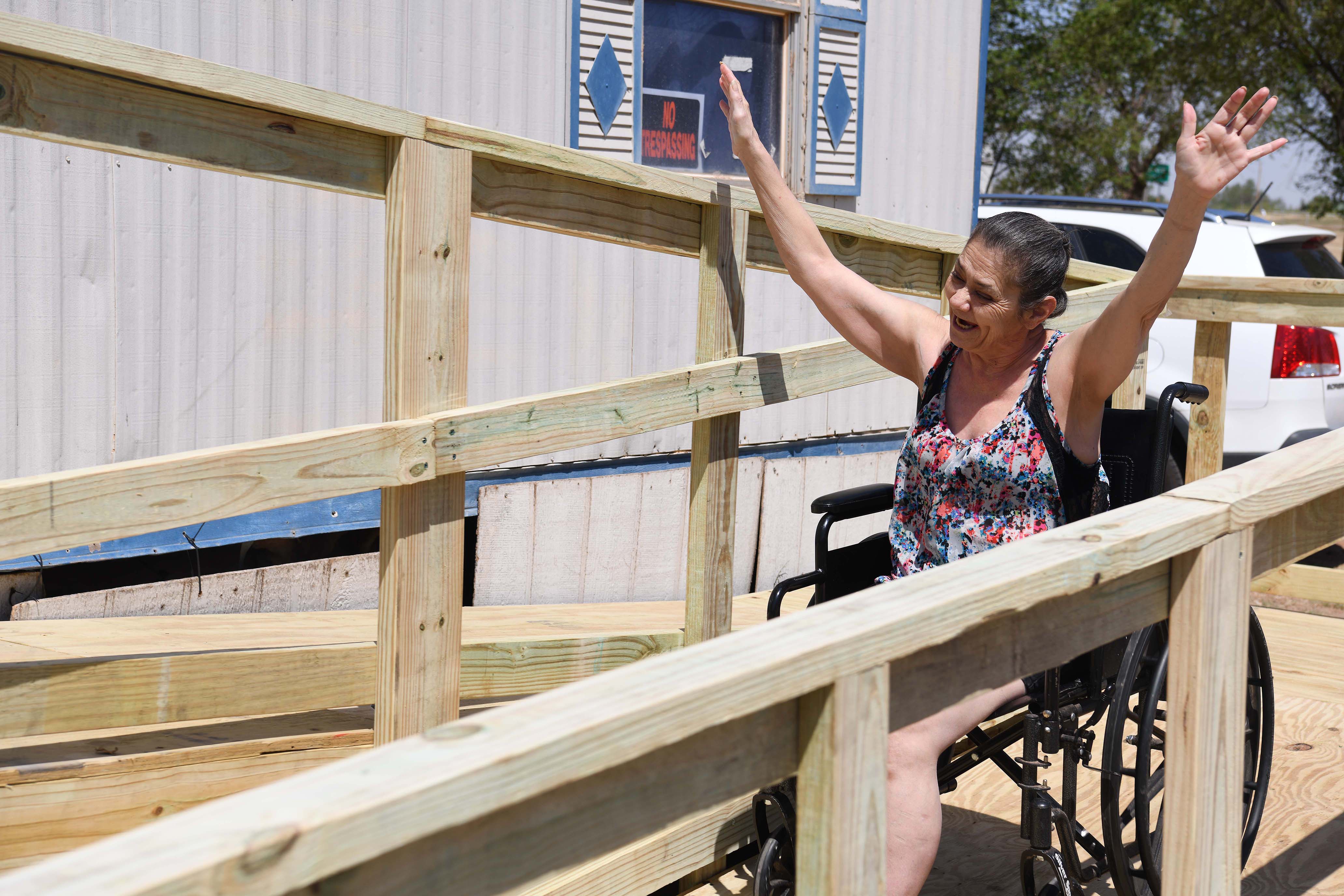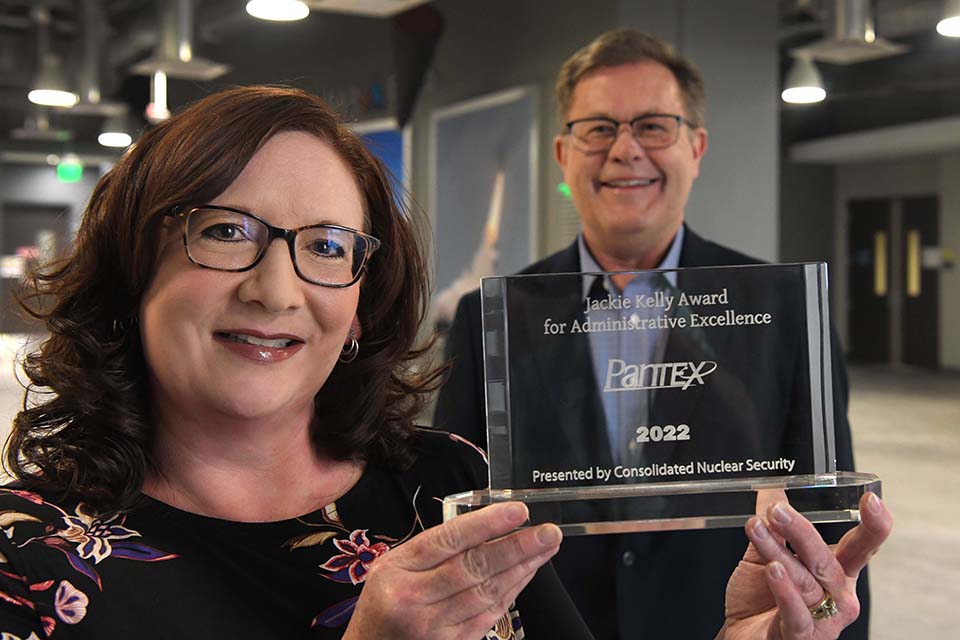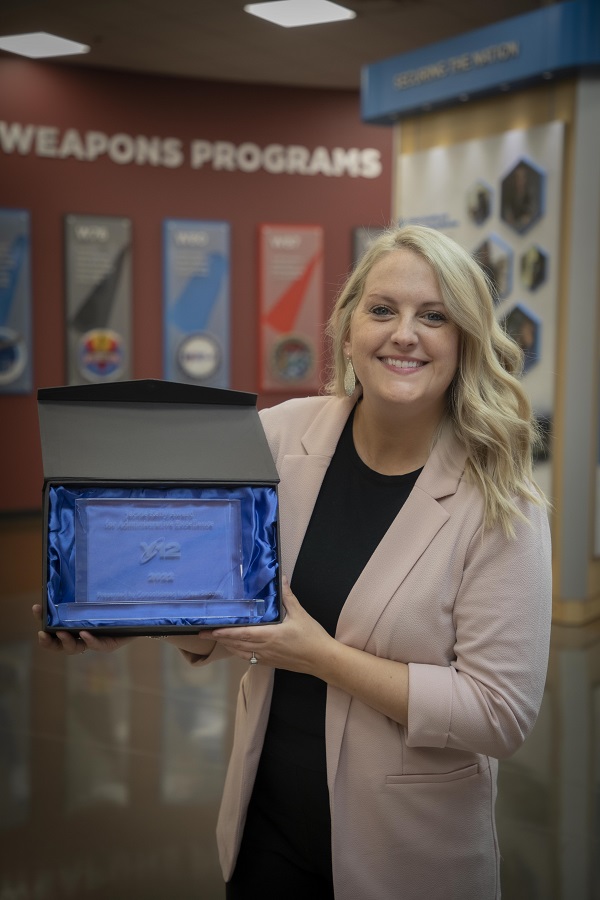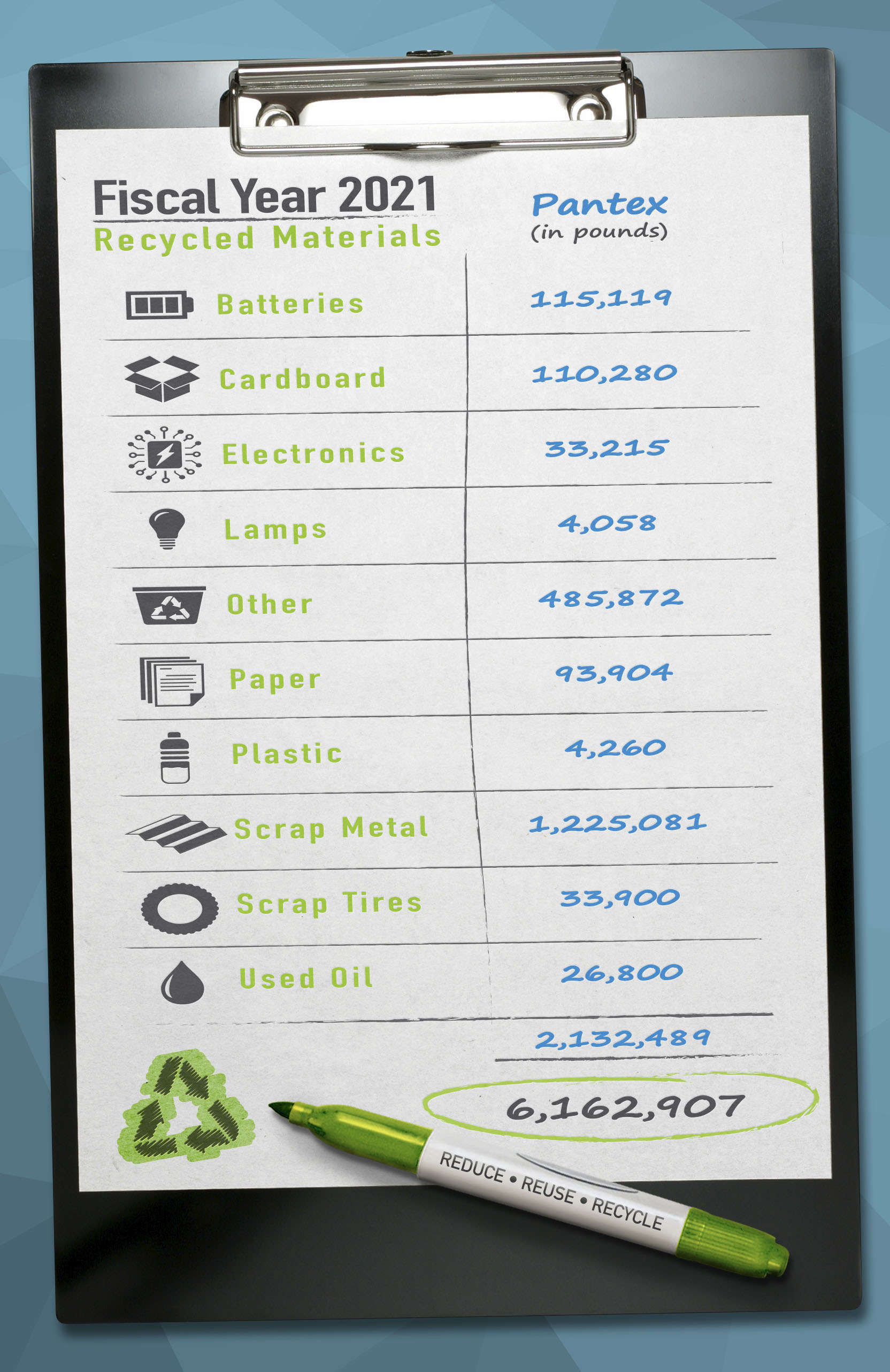Pantex Blog
Pantexans care: 2022 United Way Day of Caring
Pantex volunteers made a difference for four community members with ramps built for the Texas Ramp Project during the 2022 United Way Day of Caring
On April 29, Pantexans participated in the United Way Day of Caring. Teams built four ramps for individuals needing assistance getting in and out of their homes. The Day of Caring is a community-wide event and an opportunity for volunteers to make a real difference. CNS donated $4,000 to sponsor the projects.
Pantex Acting Deputy Site Manager Kenny Steward said, “As one of the largest employers in the Amarillo area, we have a responsibility to support our friends, neighbors, and fellow citizens in our local communities. We are honored to give back, whether through financial contributions or sweat investments, to those in need.”
There are Pantex employees who participated in Day of Caring because they feel it is important to give back to the community for personal reasons too. Alexi Khashan, section manager with Pantex Infrastructure, said, “My mother received a ramp from Texas Ramp Project, and it is important to me to be able to give back to the community.”

Training adapts and delivers for Pantex production
Instructor Brad Immel teaches a Conduct of Operations class to new production technicians in the Pantex Nuclear Incident Response Program facility.
Training is implementing creative solutions to serve Production’s significant personnel needs as it increases throughput as part of the Pantex Production Optimization effort.
“People are our most important piece of the puzzle. They enable us deliver the mission,” said Scott Elliott, Weapons Training senior manager. “We train those who put their hands directly on the units. This puts Weapons Training directly in the path of ensuring product is delivered in a quality and timely manner.”
Humans Resources is hiring more than 200 production technicians and other production support by the end of September. Those essential new hires are creating a challenge for Organization Development and Training.
To meet immediate needs, Training had to first realign the existing Weapon Training instructor and training schedule to support the most urgent programs.
“We implemented a visual status board in our training area that keeps everyone appraised of what is happening in the training bays to make sure that any scheduling conflicts affecting trainers, students, tooling, and materials can be addressed,” Elliott said. Some trainers have been taking on new roles in prioritized training classes.
Space was another issue, considering the need for social distancing, as well as available computers for new hires to complete computer-based training courses. Places such as the John C. Drummond Center auditorium and the Nuclear Incident Response Program facility are now being used to train production technicians.
Training also submitted and was approved for a Federal Acquisition Regulations deviation that allows Pantex to train on overtime, if necessary, to maintain critical program deliverables.
Elliot said the challenges taught him that there are always going be unforeseen issues and that teamwork ensures these issues are addressed.
“It takes diligence to constantly challenge yourself and your organization about our understanding of the future needs,” Elliot said. “This means we need to regularly discuss our role in the production chain and how can we ensure it stays on the proper path.”
Production technicians work on training in the JCDC auditorium.
CNS administrative professionals honored with 2022 Jackie Kelly Awards

Administrative professional Renea Dosher won the Pantex Jackie Kelly Award for 2022. With her is Deputy Chief Information Officer Rick Day, who co-nominated her with Chief Information Officer Joe Harris.
For most organizations, the group’s administrative professional is both a nexus of knowledge and the glue that holds all the parts together. They keep coworkers and their bosses on track, informed, reminded, and supported. These professionals do their complex jobs while dealing with deadlines, interruptions, and — over the past two years — all the challenges presented by the pandemic.
Nearly 100 administrative professionals work at Pantex and Y-12, helping to keep the sites’ missions running smoothly. One such stellar administrative professional was Jackie Kelly, who was known at Y-12 for meeting challenges, including the cancer that eventually ended her life. In 2017, the Jackie Kelly Award was established in her memory to recognize one outstanding administrative professional at each site.
A panel of five judges from both sites scored the nomination forms with the names and organizations redacted to ensure fairness.
The 2022 Jackie Kelly Award winners are Renea Dosher at Pantex and Melanie Fleury at Y-12.
Renea Dosher, Pantex
Dosher, senior administrative support for Information Solutions and Services, has worked at Pantex for more than six years. She said going the extra mile and striving for excellence are the keys to success.
“This role is about providing dedicated support with the best results,” she said. “It’s important to uphold accountability, professionalism, and accuracy in all tasks. The end result is not only a reflection of me, but the IS&S organization, CNS, and our mission.”
She was nominated by Chief Information Officer Joe Harris and Deputy Chief Information Officer Rick Day, noting her reputation for delivering high quality products.
“Renea has strong interpersonal skills and works equally well with technical employees and all levels of management. Her role requires that she interact with a wide mix of employees all day, every day,” they wrote in nominating Dosher.
“Renea is the ‘go to’ person for a wide range of business operation needs and will find the answers if she does not already know them,” the nomination continued. “She is a committed team player who frequently works extended hours to support deliverables and her fellow teammates.”
Dosher said the rewards of her job come from her coworkers.
“I am proud to work with some of the best people,” she said. “Their motivation, support, mentorship, and encouragement to seek out new challenges is rewarding. There is always an opportunity to learn and grow.”
Melanie Fleury, Y-12

Jackie Kelly Award winner for Y-12 Melanie Fleury poses with her plaque.
Fleury, administrative support for Mission Systems & Integration, chose to leave the workforce for eight years to care for her special-needs son. Hearing of a job posting in administrative support led to her joining Y-12.
Now, just six months later, Fleury is the Jackie Kelly Award winner at Y-12. The director she works for, Will Farmer, said in her nomination that, “Ms. Melanie displays a caring attitude by doing the small things that make a person feel confident in their own success.”
“She has become a vital part of our Mission Systems & Integration family,” Farmer wrote. “With her dedication, conscientiousness, caring, and can do attitude, Ms. Melanie has made a huge positive impact to our team. We’re truly fortunate to have her.”
Fleury said she’s the one who feels fortunate to have been blessed with the position.
My team are the most comradery minded and hard working individuals. They’ve embraced me immediately, taught me the ropes, and encouraged me along the way,” she said. “The atmosphere of Mission Systems & Integration encompasses my core values of integrity, excellence, teamwork, so it has been effortless for me to buy in to our mission.
“Things I always try to provide my team with is my time and attention. I want them to feel valued, welcomed, and appreciated. I want them to know I am happy to assist and eager to help. Everyone is important to me, no matter their title, because they are important to me as a person,” she said.
Congratulations to Renea Dosher and Melanie Fleury, who represent the legacy of Jackie Kelly.
Pantex Fire Department goes green
Fire departments are usually known for their bright red engines, but the Pantex Fire Department has recently gone green. They traded their gasoline power tools and portable power sources for battery-operated alternatives.
“Things change, and in our profession it is important to adapt,” said Scott Johnson, Pantex Fire Department battalion chief. “We are always looking for different ways to improve that are environmentally friendly, ergonomic, and economic.”
Battery-operated rescue extrication equipment, lights, and cutting saws are underutilized in the fire service, but are gaining popularity. They were once hard to find and more expensive, but now are becoming more compatible and available. The Pantex Fire Department is proud to be part of the growing number of departments using battery-operated power sources for firefighting tools and equipment.
The new tools are more sustainable because they do not rely on the use of fossil fuels. With fewer parts to maintain like exhaust ports, carburetors, air filters, mufflers, and spark plugs, they require less maintenance and are more dependable. They help to prevent firefighters from inhaling harmful vapors and carbon emissions produced while the equipment runs, as well as the off gassing of fuel vapors from the equipment being stored in closed compartments on the fire apparatus. The tools also eliminate the fuel waste that could result from improperly mixing gas and oil.
“If given the choice now, I wouldn’t go back to gas-powered tools,” said Jeremy Baker, Pantex Fire Department captain. “These need way less maintenance and are performing just as well.”
Pantex Fire Department personnel evaluated the tools in a training session with the vendor and found that their faster deployment allows them to work more efficiently. The battery-operated tools are lighter and also provide an increased level of safety. Once the operator removes their finger from the tool’s trigger, the machine turns off, instead of idling like their gas-powered counterparts. This reduces noise that may impact a firefighter’s hearing.
Pantex firefighters weighed the pros and cons of gas-powered and battery-operated tools. Refilling gas-powered equipment is often messy and can easily lead to fuel spills that could contaminate a firefighter’s personal protective equipment or the environment. Other risks include oil evaporating into the air as a volatile organic compound that could lead to a potential health risk for firefighters.
Although the benefits of battery-powered tools were clear, and they are certainly the environmentally friendly option, they do come with their own unique challenges. Batteries do not last forever, so charging them in the field can be difficult. Batteries are often heavy; it is unrealistic to assume that operators will carry the backup batteries with them. If the tool battery dies, firefighters may have to return to the truck to replace the battery prior to finishing the task.
“I’m old school, so we didn’t have anything very environmentally-friendly,” said Robert Napp, assistant chief for operations. “These zero-emission tools are a drastic change from what I’m used to, and it’s cool to see how much things have changed.”
New tool designs and more robust battery lifespans have allowed the Pantex Fire Department firefighters an opportunity to do their part to help reduce the effects of greenhouse gases and other pollutants into the environment, while keeping the safety and ergonomics of firefighters in mind.
7 Ways Pantex Protects the Environment
The Pantex Wind Farm has allowed the site to consistently exceed DOE goals regarding the use of renewable energy and reduce energy-related greenhouse gas emissions.
Pantex and Y-12 are committed to policies and practices that help protect the environment.
Those commitments can be summed up with the acronym P2C2:
- Protect the environment,
- Prevent pollution,
- Comply with applicable legal and other requirements, and
- Continual improvement.
Pantex carries out these promises on a daily basis. Here are seven ways Pantex works to help the environment.
Employing renewable energy
Since the summer of 2014, the Pantex Renewable Energy Project (PREP) has allowed the site to consistently exceed DOE goals for using renewable energy and reducing energy-related greenhouse gas emissions. The wind farm also provides both Pantex and Y-12 with renewable energy credits, which help exceed DOE sustainability goals. PREP was recently featured by DOE as the largest federal wind farm in America. Pantex also continues to use renewable energy-powered equipment such as solar-powered aerators in the wastewater lagoons, solar-powered lights at parking lots, and solar-generated power to emergency notification towers.
Buying Green
Pantex continues the tradition of acquiring products that are environmentally sustainable. During FY 2021, Pantex received the Electronic Product Environmental Assessment Tool (EPEAT) Purchaser Award for purchasing approximately 95% of monitors, computers, telephones, televisions, and other imaging systems that met the EPEAT criteria established by the Green Electronics Council. Nearly 100% of all computers and monitors save energy by using power management tools. Pantex also received the 2021 DOE Office of Sustainable Environmental Stewardship Silver Level Greenbuy Award for purchasing six green priority products in four different categories.
Recycling to prevent waste

During FY 2021, Pantex recycling efforts resulted in a total 2,132,489 pounds in recycled material. The following quantities (in pounds) of waste were shipped to various recycling companies:
- Batteries 115,119
- Cardboard 110,280
- Electronics 33,215
- Lamps 4,058
- Other 485,872
- Paper 93,904
- Plastic 4,260
- Scrap Metal 1,225,081
- Scrap Tires 33,900
- Used Oil 26,800
Reducing energy intensity
Pantex continues to work to reduce energy intensity by 20%, primarily through the use of the Pantex wind farm. Energy intensity is the amount of energy used per square foot of plant’s footprint. By 2025, the goal is to reduce energy intensity at Pantex by 30% from the 2015 baseline. Energy savings in projects such as the heating, ventilation, and air conditioning (HVAC) replacements and security lighting upgrades will further Pantex’s progress in reducing energy consumption.
Conserving water resources
The groundwater remediation program at Pantex focuses on pumping water from the perched aquifer and limiting the amount of recharge back into the perched aquifer. When contaminated water is pumped from the perched aquifer, it is treated to remove contaminants. This treated groundwater is then mixed with treated wastewater from the rest of the plant. Over the last two years, Pantex has renovated a subsurface irrigation system that, under a permit from the State of Texas, allows this treated wastewater to be beneficially reused for crop irrigation. Using the treated wastewater for irrigation increases crop production and reduces the amount of recharge going back into to the perched aquifer. During the crop growing season, between 900,000 and 1 million gallons of treated wastewater may be used in the subsurface irrigation system for the purpose of beneficial reuse. To supplement the subsurface irrigation system, Pantex is constructing a five-pivot irrigation system on Pantex property east of FM 2373. Similar to the subsurface system, the pivots will receive treated water from the plant wastewater facility and the groundwater pump and treat systems to be reused for surface irrigation of crops.
Following the rules
The State of Texas has issued Pantex an environmental compliance rating of “high,” which is the best rating that is offered by the state. The rating is based on Pantex’s compliance with its permits and authorizations and all of the environmental laws and regulations applicable to its operations. In addition, the state has classified the Pantex water supply and distribution system as “superior.” This is also the highest rating offered by the state and is based on performing operations that go beyond those required by regulation.
Reducing waste
Pantex continues to use digital technology, such as the X-ray machine in the Pantex Occupational Medical Department, to eliminate silver-contaminated film wastes and reduce annual radiography waste. Electronics equipment is dispositioned through certified recyclers, transferred, or donated to other sites and/or educational institutions through various government programs. Accordingly, 99% of electronic equipment was kept out of landfills. In addition, more than 95% of all Pantex printers have duplex printing capabilities to save paper use.
